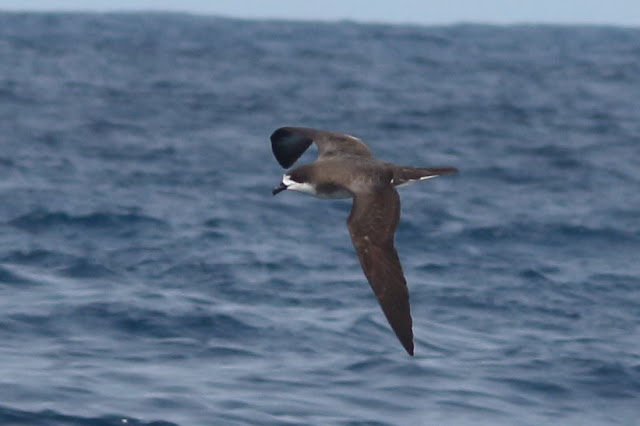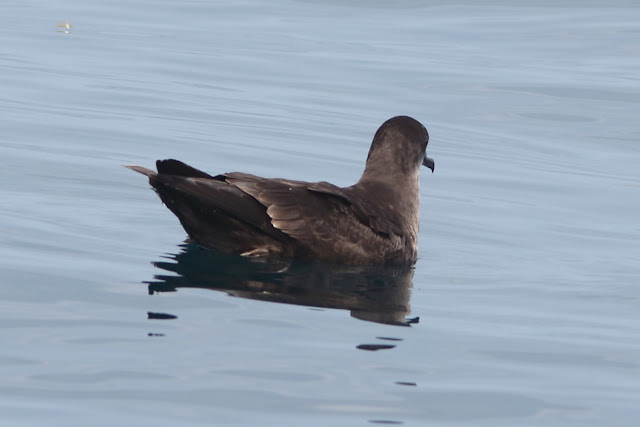My 2nd of 6 fall pelagic trips was out of Newport, OR yesterday on 8-24-19. It was a 12 hour trip designed to get us far off shore in the hopes of Pterodroma or anything else we could find. We got out to about 50 miles. Water temp started in the mid to high 50's and got up to 68 degrees. Weather was warm with light to no winds, seas calm with a few patches of swells.
Leaving Newport at 6 am.
The calm seas were a repeat of my Westport trip from two weeks ago. Many birds were seen sitting on the surface, waiting for the winds to kick up so they could move around. This South Polar Skua was one of them. Long-tailed Jaeger were the most common skua seen.
I was sure we had spotted some Sperm Whale out in deep water, but Russ figured out they were Baird's Beaked Whales. They are much smaller than more typical whales. It is only the third time I have seen these hard-to-find mysteries of the ocean. They like to dive in very deep water, down to 3,300 feet. They can stay underwater for more than an hour. This was a group of about 5 out in 6,600 feet of 68 degree water.
The back of this one is scared from teeth marks of other Baird's or perhaps a few encounters with Orca.
Very special encounter.
We picked up our skua slam when this Pomarine Jaeger flew by exhibiting excellent spoonage in the tail feathers.
We were out at the second chum spot, still way offshore, I think 49 miles, when Russ calmly called out a Hawaiian Petrel had arrived at the slick. It provided great views as it flew around the slick, it wandered about as a Storm-Petrel rather than a Pterodroma, providing great views.
At first look a Hawaiian Petrel might appear as a white-bellied shearwater, but a look at the long narrow wings and longer tail will quickly get you to a Pterodroma.
The following is taken from Steve N. G. Howell's book "Petrels, Albatrosses & Storm-Petrels of North America a Photographic Guide" (2012) .
In 2002 the AOU split the Dark-rumped Petrel into two species, the Hawaiian Petrel and the Galapagos Petrel. It seems the data used is confusing and there may be more than simply just two species involved in this group. The Hawaiian breed from Apr-Oct. They show up off west coast as nonbreeding visitors during the summer, peaking in July and August.
I was hoping to find some differences between this bird and a Galapagos Petrel. I am having a tough time! A Galapagos would be broader winged and have a cowl on the head that extends diagonally across head and neck. Hawaiian are supposed to have a small notch behind the cowl. Galapagos might have a broader dark trailing edge on underwing. Considering each island in Hawaii might have its own version of Dark-rumped Petrel, and each with slight differences in plumage it certainly is a confusing identification. The fact that the bird was off Oregon, leans to Hawaiian Petrel, though location does not seem to be a strong point when talking about pelagic birds.
Take a look at this paper : Dark-rumped Petrel
Nice view of the aerodynamics Pterodroma possess. A perfect wind foil. This bird is designed to fly with very little effort.
Narrow wing margins point to Hawaiian rather than Galapagos Petrel.
White faced bird coming right at you. This white blaze on forehead can be seen from great distance. I might have seen this bird earlier in trip, all I saw was a grayish backed petrel way out at the horizon, I never saw face well so did not see the blaze on bird,
Hmm, is that enough of a white notch behind cowl? Seems it is within range of a Hawaiian.
Wings look narrow based, but would like to see a few Galapagos flying around.
Bill is supposed to be bigger in Galapagos, not sure what to say about that.
Seems Galapagos might have dirtier flanks, the flanks were perfectly clean on this bird.
Dark cowl bleeding into gray back is a Dark-rumped Petrel trait.
The white mottling on uppertail coverts is exposed feather bases
Bi-colored legs are not that rare on pelagic species. Hawaiian Petrel have black on parts of their feet and legs, but mostly they are pink.
I think we saw more Buller's Shearwater than Sooty Shearwater. Here is a flock of 11 or so we spotted on the way back in to port.
Can you spot the Pink-footed Shearwater? Obviously larger, darker bird.
Thanks much to Oregon Pelagic Tours for the trip. Tim, Russ and Jim for the guide work, and crew of Enterprise for getting us out and back safely.
Sunday, August 25, 2019
Sunday, August 11, 2019
Westport Seabird trip 8-10-19
My fall pelagic season started yesterday out of Westport. After three trips this spring and a break for a few months, I was eager to get back out. The weather looked great, almost too nice. No wind in forecast meant birds might not be up and moving about. A very light rain shower decided to stay with the boat during the first part of the trip. But soon that stopped and fun birding began.
With no wind, the birds we saw all were happy to stay on the water for great views. I think this trip was the first Buller's Shearwater of the season for Westport. It flew in from the stern and gave everyone great looks, later we saw this one hanging on the water with a Pink-footed Shearwater.
Once well offshore we simply wandered around the dead calm seas looking for flocks of birds on the water. With the mill-pond ocean, the flocks were easy to spot from a great distance.
Usually my looks at Long-tailed Jaeger are of a flying bird passing by the boat, rarely can you sneak up on them sitting on the ocean. Yesterday we had a flock of Long-tailed (4-5 birds) on the water right near the boat. Crazy fun views on stunningly beautiful birds.
Long-tailed flying away showing off the darker flight feathers.
The bird-of-the-day for me were the Scripps's Murrelets we saw. One we caught sight of right next to the boat, with in a few feet, just sitting on the surface. I was on the other side of boat and got good views through the binoculars but missed a photo.
These two popped up while we were looking at an Arctic Tern sitting on a log, we skipped the tern and motored closer to the Scripps's. They stayed right on the surface and near the boat for the entire time we were in area.
Usually my view of a Scripps's is a rocket of a bird passing by the boat and gone before you can even call it out, not today.
I was impressed by their beautiful necks and low profile in the water. For such tiny birds they are very elegant.
This adult South Polar Skua was another cooperative bird.
I bet it can't wait to get all its flight feathers back.
The calm seas and cooperative birds allowed us to pick out a few Short-tailed Shearwaters in the Sooty flocks.
I think this is the above bird flying away.
Other than that, no Leach's Storm-Petrels but a decent supply of Fork-tailed. All the other normal stuff in good supply. A blast of a trip on a perfect day. Thanks to Bruce, Kelly, Bill, Phil and Chris.
Five more trips this fall should keep me busy.
Subscribe to:
Posts (Atom)













































